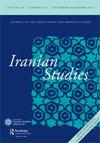Zoroastrian Middle Persian手稿中的Fārsīgraphy
IF 0.9
4区 社会学
Q2 AREA STUDIES
引用次数: 0
摘要
伊朗的文字传统源远流长,它的不断发展,不时产生新的文字。一个最显著的例子是,当新波斯语取代中古波斯语时,波斯语-阿拉伯语取代了巴列维文字,导致琐罗亚斯德教的牧师在阅读和理解他们的宗教文本方面遇到了困难。改变剧本的过程在Pāzand的传统中得到了很好的证明。虽然Pāzand被认为是伊朗最早的音译类型之一,但由于它依赖于阿维斯陀文字,这种传统也逐渐被抛弃了,这在过去和现在都是不常见的。现在在琐罗亚斯德教的中波斯(巴列维语)手稿中发现了阿维斯陀文字,就像Pāzand传统上用于早期文本一样。Pāzand-i.e。使用了一段时间,但最终被普遍使用的文字所抛弃,即波斯的波斯语和印度的古吉拉特语和Devanagari。在本文中,目的是识别和分类巴列维手稿中的这一传统的特点,借鉴了由设拉子巴列维大学亚洲研究所出版的53卷手稿,如附录所列。本文章由计算机程序翻译,如有差异,请以英文原文为准。
Fārsīgraphy in Zoroastrian Middle Persian Manuscripts
Abstract The tradition of writing in Iran has a long history, and its continuous development has, from time to time, led to new scripts. A most notable case is that of Perso-Arabic's replacement of Pahlavi script when New Persian replaced Middle Persian, resulting in Zoroastrian priests having difficulties reading and understanding their religious texts. The process of changing scripts is well attested by the tradition of Pāzand. Although Pāzand was considered one of the first types of transliteration in Iran, this tradition was also gradually abandoned due to its reliance on Avestan script, which was and continues to be uncommon. Avestan script is now found in Zoroastrian Middle Persian (Pahlavi) manuscripts, just as Pāzand was traditionally used for earlier texts. Pāzand–i.e., transcription of Middle Persian in the Avestan alphabet–was used for some time, but was eventually abandoned for scripts in common use, i.e., Persian in Persia and Gujarati and Devanagari in India. In this paper, the aim is to identify and categorize this tradition's characteristics in Pahlavi manuscripts, drawing on manuscripts from the fifty-three volumes published by the Asia Institute of the Pahlavi University of Shiraz, as listed in the Appendix.
求助全文
通过发布文献求助,成功后即可免费获取论文全文。
去求助
来源期刊

Iranian Studies
Multiple-
自引率
0.00%
发文量
92
期刊介绍:
Iranian Studies is a peer-reviewed journal devoted to Iranian and Persian history, literature, and society, published on behalf of the Association for Iranian Studies . Its scope includes all areas of the world with a Persian or Iranian legacy, especially Iran, Afghanistan, Central Asia and the Caucasus, and northern India, and Iranians in the diaspora. It welcomes submissions in all disciplines.
 求助内容:
求助内容: 应助结果提醒方式:
应助结果提醒方式:


